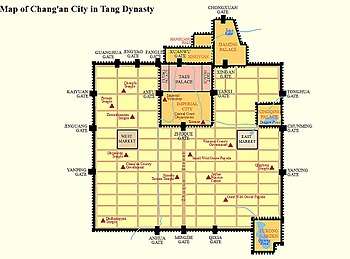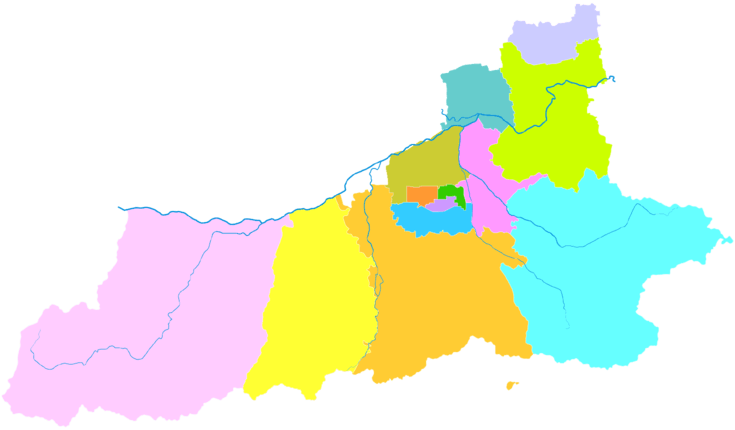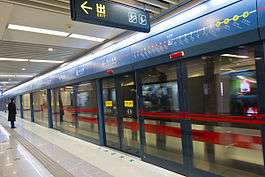Xi'an
Xi'an (UK: /ˌʃiːˈæn/ shee-AN, US: /ˌʃiːˈɑːn/ shee-AHN;[4][5][6][7] Chinese: [ɕí.án] (![]()
Xi'an 西安市 Sian, Hsi-an | |
|---|---|
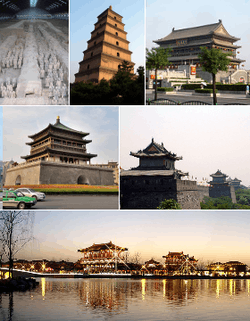 From top: Xian Terracotta Warriors Museum, Giant Wild Goose Pagoda, Drum Tower of Xi'an, Bell Tower of Xi'an, City wall of Xi'an, Tang Paradise at night | |
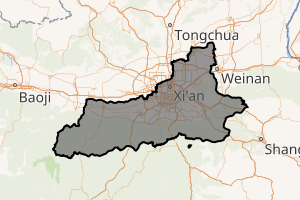
| |
.png) Location of Xi'an City jurisdiction in Shaanxi | |
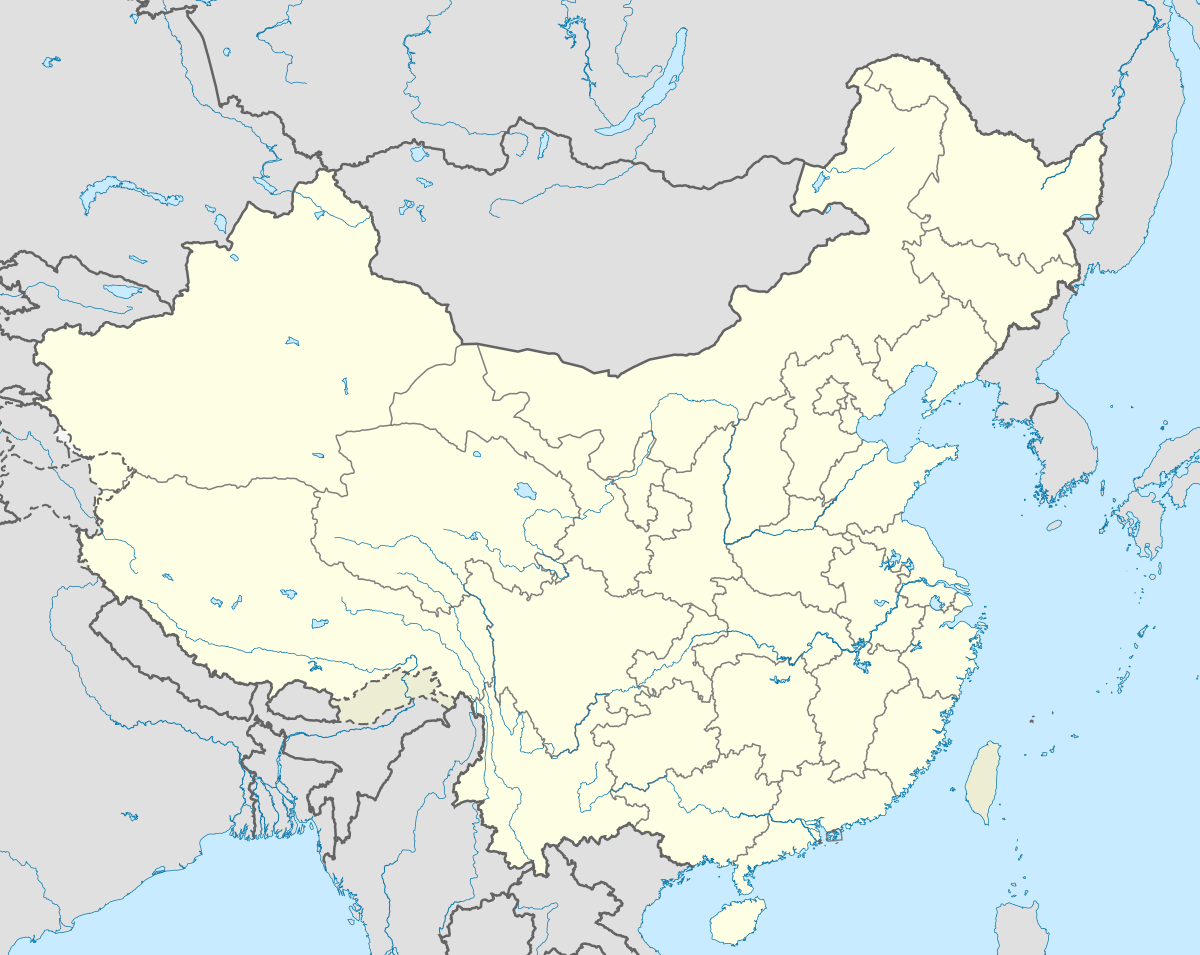 Xi'an Location in China | |
| Coordinates (Shaanxi provincial government): 34°15′54″N 108°57′14″E | |
| Country | People's Republic of China |
| Province | Shaanxi |
| Municipal seat | Weiyang District |
| Government | |
| • Party Secretary | Wang Hao |
| • Mayor | Li Mingyuan |
| Area | |
| • Sub-provincial & prefecture-level city | 9,983 km2 (3,854 sq mi) |
| • Urban (2018)[1] | 1,088 km2 (420 sq mi) |
| • Metro | 3,866.25 km2 (1,492.77 sq mi) |
| Elevation | 405 m (1,329 ft) |
| Population (2017) | |
| • Sub-provincial & prefecture-level city | 12,000,600[2] |
| • Urban (2018)[1] | 7,135,000 (10th) |
| • Metro | 12,900,000 |
| • Metro density | 3,300/km2 (8,600/sq mi) |
| Time zone | UTC+8 (CST) |
| Postal code | 710000–710090 |
| Area code(s) | 29 |
| ISO 3166 code | CN-SN-01 |
| GDP | (2017) |
| – Total | CNY748.52 billion (US$118.8 billion) |
| – Per capita | CNY71,853 (US$10,823) |
| License plate prefixes | 陕A |
| City Flower | Pomegranate flower |
| City Tree | Pagoda tree |
| Website | XA.gov.cn |
| Xī'ān | |||||||||||||||||||||||||||||||||
|---|---|---|---|---|---|---|---|---|---|---|---|---|---|---|---|---|---|---|---|---|---|---|---|---|---|---|---|---|---|---|---|---|---|
"Xi'an" in Chinese characters | |||||||||||||||||||||||||||||||||
| Chinese name | |||||||||||||||||||||||||||||||||
| Chinese | 西安 | ||||||||||||||||||||||||||||||||
| Postal | Sianfu | ||||||||||||||||||||||||||||||||
| Literal meaning | "Western Peace" | ||||||||||||||||||||||||||||||||
| |||||||||||||||||||||||||||||||||
| Cháng'ān | |||||||||||||||||||||||||||||||||
| Simplified Chinese | 长安 | ||||||||||||||||||||||||||||||||
| Traditional Chinese | 長安 | ||||||||||||||||||||||||||||||||
| Literal meaning | "Perpetual Peace" | ||||||||||||||||||||||||||||||||
| |||||||||||||||||||||||||||||||||
| Xi'an dialect (Zhongyuan Mandarin) name | |||||||||||||||||||||||||||||||||
| Xi'an dialect (Zhongyuan Mandarin) | 西安: [ɕi²¹.ŋã²¹] 長安: [ʈ͡ʂʰaŋ²⁴.ŋã²¹] | ||||||||||||||||||||||||||||||||
Since the 1980s, as part of the economic revival of inland China especially for the central and northwest regions, the city of Xi'an has re-emerged as an important cultural, industrial, and educational centre of the central-northwest region, with facilities for research and development, national security and space exploration. Xi'an currently holds sub-provincial status, administering 9 districts and 4 counties.[11] As of 2018 Xi'an has a population of 12,005,600 and the Xi'an–Xianyang metropolitan area a population of 12.9 million.[3] It is the most populous city in Northwest China, as well as one of the three most populous cities in Western China, the other two being Chongqing and Chengdu.[12] In 2012, it was named as one of the 13 emerging megacities, or megalopolises, in China.[13]
Name
"Xi'an" is the atonal pinyin romanization of the Mandarin pronunciation of its name 西安, which means "Western Peace". (The apostrophe – known in Chinese as a 隔音符號, géyīn fúhào – should be included to distinguish its pronunciation from the single syllable xian.) The name was adopted in 1369 under the early Ming dynasty. Jesuit missionaries recorded its name as "Si-ngan" or "Si-ngan-fou"[14] from its status as the seat of a prefecture (府, fǔ). This form still appears in the Latin name of the Catholic diocese of Xi'an, archidioecesis Singanensis. The name was later romanized as "Hsi-an" by Wade & Giles and as "Sianfu"[15] or "Sian"[10] by the Qing imperial post office, both of which were common until the general adoption of pinyin.
The area of present-day Xi'an has been the site of several important former Chinese cities. The capital of the Western Zhou were the twin cities of Feng and Hao, known collectively as Fenghao, located on opposite banks of the Feng River at its confluence with the southern bank of the Wei in the western suburbs of present-day Xi'an.[16] The Qin capital Xianyang was erected north of the Wei during the Warring States period and was succeeded by the Western Han capital of Chang'an (長安), meaning "Perpetual Peace", which was located south of the Wei and covered the central area of present-day Xi'an. During the Eastern Han, Chang'an was also known as Xijing (西京) or the "Western Capital", relative to its position to the main capital at Luoyang. Under the Sui, its name became Daxing (大興, "Greatly Prosperous") in AD 581. Under the Tang, the name reverted to Chang'an in 618.[10] Under the Mongolian Yuan dynasty (13th & 14th centuries), it held a succession of names: Fengyuan (奉元), Anxi (安西, "Peaceful West"), and Jingzhao (京兆). The Ming name "Xi'an" was changed back to Xijing ("Western Capital", as above) between 1930 and 1943.
Xi'an currently does not have a widely accepted one-character abbreviation as many other Chinese cities do. Its license plates are simply marked with 陕A, based on the name of its province.
History
Prehistory
Xi'an has a rich and culturally significant history. The Lantian Man was discovered in 1963 in Lantian County, 50 km (31 mi) southeast of Xi'an, and dates back to at least 500,000 years before the present time. A 6,500-year-old Neolithic village, Banpo, was discovered in 1953 on the eastern outskirts of the city proper, which contains the remains of several well organized Neolithic settlements carbon dated to 5600–6700 years ago.[17][18][19][20] The site is now home to the Xi'an Banpo Museum, built in 1957 to preserve the archaeological collection.[21]
Ancient era
Xi'an became a cultural and political centre of China in the 11th century BC with the founding of the Zhou dynasty. The capital of Zhou was established in the twin settlements of Fengjing (丰京) and Haojing, together known as Fenghao, located southwest of contemporary Xi'an. The settlement was also known as Zōngzhōu to indicate its role as the capital of the vassal states.[22] In 770 BC, the capital was moved to Luoyang due to political unrest.[23]
Imperial era
Following the Warring States period, China was unified under the Qin dynasty (221–206 BC) for the first time, with the capital located at Xianyang, just northwest of modern Xi'an.[24] The first emperor of China, Qin Shi Huang ordered the construction of the Terracotta Army and his mausoleum just to the east of Xi'an almost immediately after his ascension to the throne.[25]
In 202 BC, the founding emperor Liu Bang of the Han dynasty established his capital in Chang'an County; his first palace, Changle Palace (長樂宮, "Perpetual Happiness") was built across the river from the ruin of the Qin capital. This is traditionally regarded as the founding date of Chang'an. Two years later, Liu Bang built Weiyang Palace (未央宮, "Never Ending Palace") north of modern Xi'an. Weiyang Palace was the largest palace ever built on Earth, covering 4.8 square kilometres (1,200 acres), which is 6.7 times the size of the current Forbidden City and 11 times the size of the Vatican City.[26] The original Xi'an city wall was started in 194 BC and took 4 years to finish. Upon completion, the wall measured 25.7 km (15.97 mi) in length and 12 to 16 m (39.37–52.49 ft) in thickness at the base, enclosing an area of 36 km2 (13.90 sq mi). In the year 190, amidst uprisings and rebellions just prior to the Three Kingdoms Period, a powerful warlord named Dong Zhuo moved the court from Luoyang to Chang'an in a bid to avoid a coalition of other powerful warlords against him.
Following several hundred years of unrest, the Sui dynasty united China again in 582. The emperor of Sui ordered a new capital to be built southeast of the Han capital, called Daxing. It consisted of three sections: the Imperial City, the palace section, and the civilian section, with a total area of 84 km2 (32 sq mi) within the city walls. At the time, it was the largest city in the world. The city was renamed Chang'an by the Tang dynasty.[27] In the mid-7th century, after returning from his pilgrimage to India, the Buddhist monk Xuanzang established a translation centre for Sanskrit scriptures.
Construction of the Giant Wild Goose Pagoda began in 652. This pagoda was 64 m (209.97 ft) in height, and was built to store the translations of Buddhist sutras obtained from India by Xuanzang. In 707, construction of the Small Wild Goose Pagoda began. This pagoda measured 45 m (147.64 ft) tall at the time of completion, and was built to store the translations of Buddhist sutras by Yijing. The massive 1556 Shaanxi earthquake eventually damaged the tower and reduced its height to 43.4 m (142.39 ft).[28]
The Nestorian Stele is a Tang Chinese stele erected in 781 that documents 150 years of early Christianity in China.[29] It is a 279 cm tall limestone block with text in both Chinese and Syriac describing the existence of Christian communities in several cities in northern China. It reveals that the initial Nestorian Christian church had met recognition by the Tang Emperor Taizong, due to efforts of the Christian missionary Alopen in 635.[30]
Chang'an was devastated at the end of the Tang dynasty in 904. Residents were forced to move to the new capital city in Luoyang. Only a small area in the city continued to be occupied thereafter. During the Ming dynasty, a new wall was constructed in 1370 and remains intact to this day. The wall measures 11.9 km (7.4 mi) in circumference, 12 m (39.37 ft) in height, and 15 to 18 m (49.21–59.06 ft) in thickness at the base; a moat was also built outside the walls. The new wall and moat would protect a much smaller city of 12 km2 (4.6 sq mi).
Modern era
In October 1911, during the Xinhai revolution, revolutionaries attacked the Manchu fort in Xi'an city. Xinhai forces stormed the fort, killing some 20,000 Manchus, therefore successfully liquidated the entire population of Manchus in Xi'an city.[31][32] The Hui Muslim community of northwestern China was divided in its support for the 1911 Xinhai Revolution. The Hui Muslims of Shaanxi supported the revolutionaries and the Hui Muslims of Gansu supported the Qing. The native Hui Muslims (Mohammedans) of Xi'an joined the Han Chinese revolutionaries in slaughtering the Manchus.[33][34][35] Only some wealthy Manchus who were ransomed and Manchu females survived. Wealthy Han Chinese seized Manchu girls to become their slaves[36] and poor Han Chinese troops seized young Manchu women to be their wives.[37] Young pretty Manchu girls were also seized by Hui Muslims of Xi'an during the massacre and brought up as Muslims.[38]
A British missionary who witnessed the massacre commented that "Old and young, men and women, children alike, were all butchered... Houses were plundered and then burnt; those who would fain have laid hidden till the storm was past, were forced to come out into the open. The revolutionaries, protected by a parapet of the wall, poured a heavy, unceasing, relentless fire into the doomed Tartar (Manchu) city, those who tried to escape thence into the Chinese city were cut down as they emerged from the gates."[31][39]
In 1936, the Xi'an Incident took place inside the city during the Chinese Civil War. The incident brought the Kuomintang (KMT) and Communist Party of China to a truce in order to concentrate on fighting against the Japanese Invasion.[40] On May 20, 1949, the Communist-controlled People's Liberation Army captured the city of Xi'an from the Kuomintang force.[41]
Xi'an made headlines for being one of the many cities where the 2012 China anti-Japanese demonstrations occurred.[42][43][44]
Geography
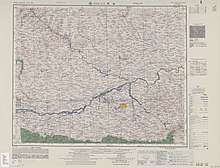
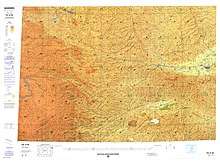
Xi'an lies on the Guanzhong Plain in the south-central part of Shaanxi province, on a flood plain created by the eight surrounding rivers and streams. The city has an average elevation of 400 metres (1,312 ft) above sea level and an annual precipitation of 553 mm (21.8 in). The urban area of Xi'an is located at 34°16′N 108°56′E. The Wei River provides potable water to the city.
The city borders the northern foot of the Qin Mountains (Qinling) to the south, and the banks of the Wei River to the north. Hua Shan, one of the five sacred Taoist mountains, is located 100 km (62 mi) away to the east of the city. Not far to the north is the Loess Plateau.
At the beginning of Han dynasty, Prime Minister Zhang Liang advised the emperor Liu Bang to choose Guanzhong as the capital of the Han dynasty: "Guanzhong Plain, which is located behind Xiao Pass and Hangu Pass, connects Long (Gansu) and Shu (Sichuan). Lands of thousand miles rich in harvest be found here, as if this place belongs to the nation of heaven." (关中左崤函,右陇蜀,沃野千里,此所谓金城千里,天府之国也) Since then, Guanzhong is also known as the 'Nation of the Heaven'.[45]
Climate
| Xi'an | ||||||||||||||||||||||||||||||||||||||||||||||||||||||||||||
|---|---|---|---|---|---|---|---|---|---|---|---|---|---|---|---|---|---|---|---|---|---|---|---|---|---|---|---|---|---|---|---|---|---|---|---|---|---|---|---|---|---|---|---|---|---|---|---|---|---|---|---|---|---|---|---|---|---|---|---|---|
| Climate chart (explanation) | ||||||||||||||||||||||||||||||||||||||||||||||||||||||||||||
| ||||||||||||||||||||||||||||||||||||||||||||||||||||||||||||
| ||||||||||||||||||||||||||||||||||||||||||||||||||||||||||||
Xi'an has a temperate climate that is influenced by the East Asian monsoon, classified under the Köppen climate classification as situated on the borderline between a semi-arid climate (BSk) and humid subtropical climate (Cwa). The Wei River valley is characterised by hot, humid summers, cold, dry winters, and dry springs and autumns. Most of the annual precipitation is delivered from July to late October. Snow occasionally falls in winter but rarely settles for long. Dust storms often occur during March and April as the city rapidly warms up. Summer months also experience frequent but short thunderstorms. The monthly 24-hour average temperature ranges from around the freezing mark in January to 27.0 °C (80.6 °F) in July, with an annual mean of 14.08 °C (57.3 °F). With monthly percent possible sunshine ranging from 31 percent in December to 47 percent in August, the city receives 1,536 hours of bright sunshine annually. Extremes since 1951 have ranged from −20.6 °C (−5 °F) on January 11, 1955 to 41.8 °C (107 °F) on June 21, 1998. A highest record of 42.9 °C (109 °F) was registered in another station on June 17, 2006.[46][47]
| Climate data for Xi'an (normals 1981–2010, extremes 1951–2013) | |||||||||||||
|---|---|---|---|---|---|---|---|---|---|---|---|---|---|
| Month | Jan | Feb | Mar | Apr | May | Jun | Jul | Aug | Sep | Oct | Nov | Dec | Year |
| Record high °C (°F) | 17.0 (62.6) |
24.1 (75.4) |
31.3 (88.3) |
34.9 (94.8) |
38.6 (101.5) |
41.8 (107.2) |
41.0 (105.8) |
40.0 (104.0) |
38.5 (101.3) |
34.1 (93.4) |
24.5 (76.1) |
21.6 (70.9) |
41.8 (107.2) |
| Average high °C (°F) | 5.1 (41.2) |
8.9 (48.0) |
14.4 (57.9) |
21.5 (70.7) |
26.6 (79.9) |
31.4 (88.5) |
32.4 (90.3) |
30.3 (86.5) |
25.6 (78.1) |
19.3 (66.7) |
12.4 (54.3) |
6.3 (43.3) |
19.5 (67.1) |
| Daily mean °C (°F) | 0.3 (32.5) |
3.6 (38.5) |
8.7 (47.7) |
15.4 (59.7) |
20.5 (68.9) |
25.3 (77.5) |
27.0 (80.6) |
25.1 (77.2) |
20.3 (68.5) |
14.1 (57.4) |
7.2 (45.0) |
1.5 (34.7) |
14.1 (57.4) |
| Average low °C (°F) | −3.3 (26.1) |
−0.4 (31.3) |
4.1 (39.4) |
10.3 (50.5) |
15.1 (59.2) |
19.9 (67.8) |
22.3 (72.1) |
21.0 (69.8) |
16.5 (61.7) |
10.2 (50.4) |
3.2 (37.8) |
−2.2 (28.0) |
9.7 (49.5) |
| Record low °C (°F) | −20.6 (−5.1) |
−18.7 (−1.7) |
−7.6 (18.3) |
−4 (25) |
3.5 (38.3) |
9.2 (48.6) |
15.1 (59.2) |
12.1 (53.8) |
4.8 (40.6) |
−1.9 (28.6) |
−16.8 (1.8) |
−19.3 (−2.7) |
−20.6 (−5.1) |
| Average precipitation mm (inches) | 6.7 (0.26) |
9.8 (0.39) |
27.1 (1.07) |
37.5 (1.48) |
54.9 (2.16) |
64.5 (2.54) |
97.5 (3.84) |
78.6 (3.09) |
94.1 (3.70) |
61.7 (2.43) |
21.5 (0.85) |
7.3 (0.29) |
561.2 (22.1) |
| Average precipitation days (≥ 0.1 mm) | 3.4 | 4.0 | 6.4 | 7.8 | 8.2 | 8.8 | 9.9 | 10.0 | 11.6 | 9.9 | 5.5 | 3.6 | 89.1 |
| Average relative humidity (%) | 65 | 62 | 64 | 64 | 65 | 61 | 68 | 75 | 77 | 76 | 73 | 68 | 68 |
| Mean monthly sunshine hours | 88.4 | 96.1 | 116.6 | 142.8 | 169.5 | 179.7 | 181.1 | 168.1 | 121.0 | 98.9 | 92.4 | 81.0 | 1,535.6 |
| Percent possible sunshine | 32 | 34 | 33 | 38 | 40 | 43 | 44 | 47 | 34 | 32 | 32 | 31 | 37 |
| Source: China Meteorological Administration,[48] all-time extreme temperature[47] | |||||||||||||
National Time Service Centre
The Shaanxi Astronomical Observatory was established in 1966. In 1975, according to the Geodetic Origin Report of the People's Republic of China, 'in order to avoid bias in the mensuration as much as possible, the Geodetic Origin would be in central mainland China.' Lintong (临潼), a town near Xi'an was chosen. Since 1986, Chinese Standard Time (CST) was set from NTSC. The NTSC in Lintong is 36 km (22 mi) away from Xi'an.
National Time Service Centre (NTSC), the Chinese Academy of Sciences is an institute which is mainly engaged in the service and research on time and frequency. NTSC takes charge of generating and maintaining the national standard time scale, disseminating the time and frequency signals. The autonomous standard time scales of universal time and atomic time and the dissemination techniques with LF radio and HF radio were established successively during the 1970s and 1980s, which meet all the requirements for different applications on the whole, such as the scientific researches, national economy, etc.[49]
Demographics
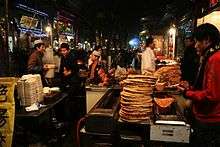
As of 2015 Xi'an has a population of 8.7 million.[2] Compared to the census data from 2000, the population has increased by 656,700 persons from 7.41 million.[50] The population is 51.66 percent male and 48.34 percent female.[50] Among its districts, Yanta has the largest population, with 1.08 million inhabitants.[50]
The encompassing Xi'an-Xianyang metropolitan area was estimated by the OECD (Organisation for Economic Co-operation and Development) to have, as of 2010, a population of 12.9 million,[3] and locally as 13,569,700,[51] of which 5,740,000 is urban.[52]
The majority of Xi'an residents are Han Chinese, who make up 99.1 percent of the city's total population. There are around 81,500 people belonging to ethnic minorities living in Xi'an, including 50,000 Hui people.
During World War II, Xi'an became a destination for many refugees from other provinces of China, especially neighboring Henan Province. Because Xi'an was far inland, the invading Japanese army only managed a few aerial assaults on the city. As a result, Xi'an suffered minimal destruction. After 1949, the national government tried to balance the development in different regions of China, and relocated a number of factories and universities from other cities to Xi'an. Modern Xi'an Jiaotong University was relocated from its original campus in Shanghai.
| Division | Permanent residents[53] | Hukou residents[54] | ||
|---|---|---|---|---|
| Total | Percentage | Population density (persons/km2) | ||
| Xi'an City | 8,467,837 | 100 | 838.66 | 7,827,260 |
| Xincheng District | 589,739 | 6.96 | 19,574.51 | 503,641 |
| Beilin District | 614,710 | 7.26 | 26,298.54 | 732,494 |
| Lianhu District | 698,513 | 8.25 | 18,226.61 | 640,911 |
| Baqiao District | 595,124 | 7.03 | 1,833.97 | 508,535 |
| Weiyang District | 806,811 | 9.53 | 3,051.39 | 516,968 |
| Yanta District | 1,178,529 | 13.92 | 7,782.38 | 793,103 |
| Yanliang District | 278,604 | 3.29 | 1,139.26 | 252,449 |
| Lintong District | 655,874 | 7.75 | 716.04 | 697,586 |
| Chang'an District | 1,083,285 | 12.79 | 681.94 | 980,803 |
| Gaoling District | 333,477 | 3.94 | 1,169.98 | 294,507 |
| Huyi District | 556,377 | 6.57 | 434.87 | 597,071 |
| Lantian County | 514,026 | 6.07 | 256.25 | 643,605 |
| Zhouzhi County | 562,768 | 6.65 | 191.08 | 665,587 |
Administrative divisions
The sub-provincial city of Xi'an has direct jurisdiction over 11 districts and 2 counties:
| Map | ||||||||||||
|---|---|---|---|---|---|---|---|---|---|---|---|---|
| Division code[55] | English | Chinese | Pinyin | Area in km2[56] | Seat | Postal code | Subdivisions[57] | |||||
| Subdistricts | Towns | Residential communities | Villages | |||||||||
| 610100 | Xi'an | 西安市 | Xī'ān Shì | 10,096.81 | Weiyang District | 710000 | 113 | 55 | 766 | 2984 | ||
| 610102 | Xincheng District | 新城区 | Xīnchéng Qū | 30.13 | Xiyi Road Subdistrict (西一路街道) | 710000 | 9 | 105 | ||||
| 610103 | Beilin District | 碑林区 | Bēilín Qū | 23.37 | Zhangjiacun Subdistrict (张家村街道) | 710000 | 8 | 100 | ||||
| 610104 | Lianhu District | 莲湖区 | Liánhú Qū | 38.32 | Beiyuanmen Subdistrict (北院门街道) | 710000 | 9 | 127 | 5 | |||
| 610111 | Baqiao District | 灞桥区 | Bàqiáo Qū | 324.50 | Fangzhicheng Subdistrict (纺织城街道) | 710000 | 9 | 40 | 223 | |||
| 610112 | Weiyang District | 未央区 | Wèiyāng Qū | 264.41 | Zhangjiabao Subdistrict (张家堡街道) | 710000 | 12 | 114 | 147 | |||
| 610113 | Yanta District | 雁塔区 | Yàntǎ Qū | 151.44 | Xiaozhai Road Subdistrict (小寨路街道) | 710000 | 8 | 123 | 84 | |||
| 610114 | Yanliang District | 阎良区 | Yánliáng Qū | 244.55 | Fenghuang Road Subdistrict (凤凰路街道) | 710089 | 5 | 2 | 23 | 80 | ||
| 610115 | Lintong District | 临潼区 | Líntóng Qū | 915.97 | Lishan Subdistrict (骊山街道) | 710600 | 23 | 36 | 284 | |||
| 610116 | Chang'an District | 长安区 | Cháng'ān Qū | 1,588.53 | Weiqu Subdistrict (韦曲街道) | 710100 | 25 | 47 | 659 | |||
| 610117 | Gaoling District | 高陵区 | Gāolíng Qū | 285.03 | Luyuan Subdistrict (鹿苑街道) | 710200 | 3 | 3 | 8 | 88 | ||
| 610118 | Huyi District | 鄠邑区 | Hùyì Qū | 1,279.42 | Ganting Subdistrict (甘亭街道) | 710300 | 1 | 13 | 21 | 518 | ||
| 610122 | Lantian County | 蓝田县 | Lántián Xiàn | 2,005.95 | Languan Subdistrict (蓝关街道) | 710500 | 1 | 18 | 8 | 520 | ||
| 610124 | Zhouzhi County | 周至县 | Zhōuzhì Xiàn | 2,945.20 | Erqu Subdistrict (二曲街道) | 710400 | 1 | 19 | 14 | 376 | ||
Transportation

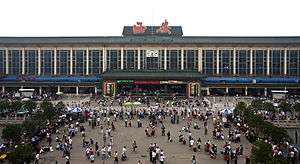
Xi'an has many areas that are easily accessible on foot. In many commercial, residential, educational zones in the city, especially in the shopping and entertainment districts around the Bell Tower, underpasses and overpasses have been built for the safety and convenience of pedestrians.
Electric bikes are popular among students and offer easy transportation in and around the city for many residents. A bicycle-sharing network started operating in 2013 and today has 52,000 bikes, used by over 200,000 people per day.[58] Taxi services are numerous, but many citizens of Xi'an still commute to work using the city's 270 official municipal bus routes serviced by a fleet of over 7,800 buses, with an average system-wide ridership of over 4 million people per day.[58] The bus network is complemented by a rapidly expanding subway system that carries over 1.5 million commuters per day.[58] There are more than 2 million registered automobiles[59] in Xi'an; the growing number of personal automobiles also means traffic jams are a common urban issue.
Metro
Line 2, running through the city from north (North Railway Station) to south (Weiqu Nan), was the first line opened to the public on September 16, 2011.[60] Operations began on September 28, 2011.[60][61] This line is 19.9 kilometres (12.4 miles) long with 17 stations.[62] Line 1 opened on September 15, 2013. As a west–east railway, its 19 stations connect Houweizhai and Fangzhicheng. Line 3 runs from northeast (Baoshuiqu) to southwest (Yuhuazhai) and opened on November 8, 2016. Line 4, which is basically parallel to Line 2 on its east, runs from the North Square of the North Railway Station [Beikezhan (Beiguangchang)] to south (Hangtianxincheng) and was available publicly on December 26, 2018.
Eight lines are planned to be finished around 2021. It will mainly service the urban and suburban districts of Xi'an municipality and part of nearby Xianyang City.[63]
The subway system covers some of the most famous attractions, such as Banpo Museum (Banpo Station, Line 1), Bell and Drum Tower (Line 2), Fortifications of Xi'an (Line 2), the Giant Wild Goose Pagoda (Line 3 and Line 4), the Daminggong National Heritage Park (Line 4) and Shaanxi History Museum (Line 2, 3 and 4), etc.[64]
The first metro departure time for Line 1, 2, 3 and 4 is 6:00, the last metro departure time for Line 3 and 4 is 23:00, for Line 1 is 23:30, and for Line 2 is 23:50.[65]
On December 30, 2008, a fire accident occurred that was extinguished within an hour and all workers evacuated safely. Sixty-six hours later, on January 2, another fire occurred at another station on Line 2.[66]
Taxi
Taxis in Xi'an are predominantly BYD Auto made in Xi'an. Most, if not all, taxis in Xi'an run on compressed natural gas. For the taxis' fare, during the period of 06:00 through 23:00, ¥9/2 kilometres (1.2 miles) for the fare fall and ¥2.3/km later, at night ¥10 for the fare fall and ¥2.7/km later.
Rail
There are 6 passenger transport railway stations in Xi'an. Xi'an railway station, located just north of Xi'an walled city, is one of the eight major national railway stations, and the main railway transportation hub of Shaanxi Province. The new Xi'an North railway station, situated a few miles to the north, is the station for the high-speed trains of the Zhengzhou–Xi'an High-Speed Railway. With 34 platforms, it is the largest railway station in Northwest China.[67] Construction of the station began on September 19, 2008.[68] The station was opened on January 11, 2011.[67] As of May 2012, Xi'an North Station is served only by the fast (G-series and D-series) trains running on the Zhengzhou–Xi'an high-speed railway; one of them continues south to Hankou.[69] The city's other stations include Xi'an West, Xi'an East, Xi'an South, Sanmincun, and Fangzhicheng railway stations.
Xi'an Railway Station covers 597,000 square metres (6,430,000 square feet), has 5 passenger platforms, and 24 tracks. It provides 112 services to 80 000 people daily. Among the destinations served by direct trains from Xi'an are Beijing, Zhengzhou, Lanzhou, Baoji, and Mount Hua. China Railway High-speed 2 now run an express services from Xi'an to Baoji and Xi'an to Zhengzhou; with a total running time to Baoji of under 90 minutes, and 2 hours to Zhengzhou. The Zhengzhou–Xi'an high-speed railway also serves Xi'an. Construction work began on September 25, 2005, the railway opened for service on February 6, 2010.[70][71][72] The railway has made air service between Zhengzhou and Xi'an uncompetitive. All passenger flights between the two cities were suspended within 48 days of start of regular high-speed rail service.[73]
Expressways
Xi'an currently has three ring road systems, the Second Ring road and the Third Ring road which encircle the city. These ring roads are similar to freeways, except where there are traffic signals on the Second Ring road.
As a tourist city, Xi'an has built expressways to Lintong, Tongchuan and Baoji, with well-maintained roads to famous scenic spots in suburban counties and to the north slope of the Qin Mountains. Since its construction in September 2007, the G5 Beijing–Kunming Expressway connects Hanzhong and Xi'an through the Qinling.
Air
Xi'an Xianyang International Airport (airport code: XIY) is the major airport serving the city and it is the largest airport in the northwestern part of China. It is 41 kilometres (25 mi) northwest of Xi'an city centre, and 13 kilometres (8.1 mi) northeast of the centre of Xianyang.[74] China Eastern Airlines, Hainan Airlines and China Southern Airlines are the main airlines using the airport. Terminal 3 and the second runway were opened on May 3, 2012.[75]
International Routes: There are direct flights from Xi'an to many major cities in Asia, including Bangkok, Busan, Fukuoka, Hong Kong, Kuala Lumpur, Manila, Osaka, Sapporo, Singapore Seoul, and Taipei. First direct route between Xi'an and Europe was launched by Finnair on June 14, 2013. There are 3 three frequencies per week via Helsinki hub to many major cities in Europe during the summer season. United Airlines begun non-stop service to San Francisco since May 2016.
Germany's Fraport, the operator of Frankfurt Airport, has paid 490 million yuan to obtain a 24.5 percent stake in the Xianyang International Airport, offering opportunities to upgrade and expand the facility.
Culture
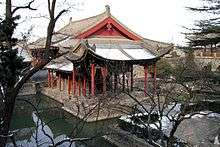
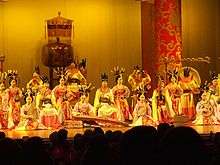
The culture of Xi'an descends from one of the world's earliest civilizations. The Guanzhong Ren (simplified Chinese: 关中人; traditional Chinese: 關中人; pinyin: Guānzhōng rén) culture is considered the cultural antecedent of Xi'anese; their features are satirized as the "Ten Strangenesses of Guanzhong Ren" (simplified Chinese: 关中十大怪; traditional Chinese: 關中十大怪; pinyin: Guānzhōng shí dà guài). Xi'an is also known for the "Eight Great Sights of Chang'an" (simplified Chinese: 长安八景; traditional Chinese: 長安八景; pinyin: Cháng'ān bājǐng), a collection of scenic areas in the region. Xi'an guyue is named for Xi'an.
Arts district
Much like Beijing 1798 and Shanghai 1933, Xi'an has an art district called Textile Town (Chinese: 纺织城; pinyin: Fǎngzhī chéng). The district derives its name from the many textile factories built there since the 1950s.[79] Today it is no longer a centre for the textile industry but a new art factory with 4 workshops in total.
Resident artists
Xi'an is home to contemporary Chinese stars such as Xu Wei,[80] Zhang Chu and Zheng Jun.
Xi'an cuisine
Yangrou paomo (flat bread soaked in lamb soup; simplified Chinese: 羊肉泡馍; traditional Chinese: 羊肉泡饃; pinyin: Yángròu pàomó)[81] is a well known Xi'anese dish.
Biangbiang mian, also known as youpo chemian (simplified Chinese: 油泼扯面; traditional Chinese: 油潑扯麵; pinyin: Yóupō chěmiàn), are thick and long hand-pulled noodles, often served with red hot pepper.
Roujiamo (meat buns; simplified Chinese: 肉夾馍; traditional Chinese: 肉夾饃; pinyin: Ròujiāmó) is a type of steamed bun, filled with meat (usually pork, but other types of meat may also be found). It is often called a chinese hamburger by locals.
Opera
Qinqiang (Voice of Qin) is the oldest and most extensive of the four major types of Chinese opera.[82] Also called "random pluck" (Chinese: 乱弹; pinyin: Luàntán), Qinqiang is the main type of drama in Shaanxi province.[83] As the earliest ancestor of Peking opera, Yu Opera, Sichuan opera and Hebei Opera, Qinqiang has developed its own system of unique vocal music, spoken parts, facial makeup, posture, role, category and acting. It can be traced to Xi Qinqiang (Chinese: 西秦腔; pinyin: Xi qínqiāng; lit.: 'Voice of West Qin') in Qin dynasty, and blossomed until Qing dynasty, with direct influences on many branches of Chinese Opera.[84]
Cinema
Zhang Yimou and Gu Changwei are directors from Xi'an. Zhang Yimou is also the only director in China to win the Golden Bear (Berlin Film Festival) twice. The first film is Red Sorghum and the second one is Tuya's Marriage. They are produced by Xi'an Filmmaking Factory (now called Xi'an Qujiang Filmmaking Group) and Xi'an Filmmaking Company, respectively.
Religion
Chinese traditional religion and Taoism
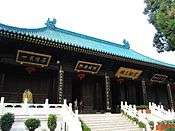
The most influential religions in Xi'an are the Chinese traditional religion and Taoist schools, represented by many major and minor temples. Among these there are a City God Temple, completely reconstructed in the 2010s, and a Temple of Confucius.
Buddhism
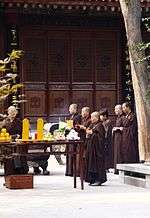
Buddhism has a large presence in the city, with temples of the Chinese and Tibetan schools.
Christianity
The first recorded Christian missionary in China was Alopen, a Syriac-speaker, who arrived in Xi'an (then known as Chang'an) in 635 along the Silk Road. The Nestorian Stele, now located in Xi'an's Beilin Museum, is a Tang Chinese stele erected in 781 that documents the 150 years of early Christianity in China following Alopen.[29] It is a 279-centimetre-tall (110-inch) limestone block with text in both Chinese and Syriac describing the existence of Christian communities in several cities in northern China. The Daqin Pagoda, a Buddhist pagoda in Zhouzhi County of Xi'an, has been suggested to have originally been a Nestorian Christian church from the Tang Dynasty.[85]
Baptist missionaries from England ran a hospital in Xi'an.[86] In 1892, Arthur Gostick Shorrock[87] and Moir Duncan[88] founded the Sianfu Mission, in present-day Xi'an.[89][90][91]
Islam
Xi'an was the first city in China to be introduced to Islam. Xi'an has a large Muslim community, the significant majority are from the Hui group, there are an estimated 50,000 Hui Muslims in Xi'an.[92] There are seven mosques in Xi'an, the best known being the Great Mosque.[93]
Economy
As part of the China Western Development policy, Xi’an became a major target for accelerated attention. From 1997 to 2006, the industrial output value of Xi’an's service industry increased at an annual average rate of 13.74 percent, compared to traditional service industries of 0.74 percent, representing a growth from US$8.113 billion to US$25.85 billion.[94] Xi'an is the largest economy of the Shaanxi province, with a GDP of 324.1 billion Yuan in 2010. On average this value increases by 14.5 percent annually, and accounts for approximately 41.8 percent of Shaanxi's total GDP.[94][95] At least fifty-eight countries have established over 2,560 enterprises in Xian, including nineteen of the Fortune 500 enterprises. These include ABB Group, Mitsubishi, Panasonic, Toshiba, Fujitsu, Coca-Cola, and Boeing.[96]
Important industries include equipment manufacturing, tourism, and service outsourcing.[97] The manufacturing industry had an annual output of RMB 36.5 billion, accounting for 44.5 percent of the city's total.[95] Furthermore, as one of China's four ancient capitals,[98] Xi'an's many cultural sites, including the Terracotta Army, the City Wall of Xi'an, and the Famen Temple, make tourism an important industry as well. In 2010, 52 million domestic tourists visited Xi'an, earning a total income of RMB 40.52 billion. On average, revenue increases by 36.4 percent per year, and foreign-exchange earnings (530 million in 2009) increase by around 35.8 percent.[95]
Xi'an is also one of the first service outsourcing cities in China, with over 800 corporations in the industry. The city's output value from this sector exceeded RMB 23 billion in 2008. Employment in the sector doubled from 1997–2006, from a base of 60,000, and computer consulting also doubled from 16,000 to 32,000.[94] As a result of the importance of the software-outsourcing industry, the city planned construction of a Software New Town, which is scheduled to be completed in 2015 with 30 billion RMB investment.[95] Other major export goods include lighting equipment and automobile parts, while its major import goods are mechanical and electrical products. Internationally, Xi'an's largest trade partner is the United States.[95]
Xi'an is part of the West Triangle Economic Zone, along with Chengdu and Chongqing.
Industrial zones
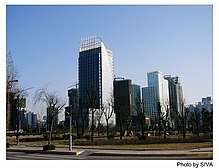
Major industrial zones in Xi'an include:
- Xi'an Economic and Technological Development Zone
- Xi'an Hi-Tech Industries Development Zone
a daily average of 3.7 technology enterprises established in Xi'an Hi-Tech Industries Development Zone in the year of 2005, from XINHUANET.com July 28, 2005[99] Xi'an Hi-Tech Industries Development Zone has more than 16,000 enterprises which ranked second place in all the 88 hi-tech ZONES in China, achieved a total revenue of 522.223 billion yuan. It is worth mentioning that 13 enterprise's annual income is over a hundred billion yuan, 19 enterprise's annual income more than 50 billion, more than 265 enterprise earns over billion yuan each year, Listed companies at home and abroad have accumulated 50, of which the domestic A-share market issued 21 of them, accounting for more than 60% of the province; 4 GEM listed companies, ranking first in the Midwest high-tech zones.
The Jiangcungou landfill in Xi'an was China's largest landfill site before its closure in 2019.[100]
Software and outsourcing industries
The growing economy of Xi'an supports the development of a software industry, and the city is a pioneer in software industry in China. The Xi'an Software Park within the Xi'an Hi-Tech Industries Development Zone (XDZ) has attracted over 1,085 corporations and 106,000 employees as of 2012.[101] A Silicon.com article describes Xi'an: "But Xi'an is selling on its own merits—with a large pool of cheap human resources from the 100 universities in the area, it hoovers up around 3,000 computer graduates every year, each earning approximately $120 a month—half the wages for the equivalent job in Beijing."[102][103]
Aerospace industry
In November 2006, Xi'an and the China Aerospace Science and Technology Corporation jointly set up Xi'an Aerospace Science and Technology Industrial Base. From its establishment, the base has focused on the development of the civil space industry, including equipment manufacturing, software and service outsourcing, new materials and solar photovoltaics.
Apart from the core area, the base will cover Xi'an and the Guanzhong area and the expansion zone will reach other parts of Northwest China and Southwest China. It is expected that by 2012 the total industry output can reach 2.8 billion us dollars with about 10 to 20 brand products with intellectual property rights and 5 to 8 products with global competitiveness.
In 2008, after the launch of the initial aerospace centre in Shanghai, the PRC is constructing another civil aerospace centre in the Shaanxi province. The State Development and Reform Commission approved the planning of Xi'an National Civil Aerospace Industrial Base on December 26, 2007. The National Civil Aerospace Industrial Base of Xi'an, set to cover 23 km2 (8.9 sq mi), will focus on developing satellites, new materials, energies, IT and other technologies for civil applications.
Notable businesspeople
Zhang Chaoyang (张朝阳), the CEO of SOHU (Nasdaq), born and raised in Xi'an, is a prominent leader in the Chinese Internet industry. Liu Chuanzhi, the founder and president of Lenovo Group Limited, completed his tertiary degree from Xidian University in the 1960s.
Education
Public

- Xi'an Jiaotong University (西安交通大学)
- Northwestern Polytechnical University (西北工业大学)
- Xidian University (西安电子科技大学)
- Chang'an University (长安大学)
- Northwest University (西北大学)
- Northwest University of Political Science and Law (西北政法大学)
- Shaanxi Pre-school Normal University (陕西学前师范学院)
- Shaanxi Normal University (陕西师范大学)
- Xi'an Academy of Fine Arts (西安美术学院)
- Xi'an Conservatory of Music (西安音乐学院)
- Xi'an Institute of Post & Telecommunications (西安邮电大学)
- Xi'an International Studies University (西安外国语大学)
- Xi'an Physical Education Institute (西安体育学院)
- Xi'an Polytechnic University (西安工程大学)
- Xi'an Petroleum University (西安石油大学)
- Xi'an Technological University (西安工业大学)
- Xi'an University of Architecture and Technology (西安建筑科技大学)
- Xi'an University of Arts and Science(Xi‘an University) (西安文理学院)
- Xi'an University of Finance and Economics (西安财经学院)
- Shaanxi University of Science and Technology (陕西科技大学)
- Xi'an University of Science and Technology (西安科技大学)
- Xi'an University of Technology (西安理工大学)
Military
- Air Force Engineering University (空军工程大学)
- The Air Force Medical University(空军军医大学)
- PLA Rocket Force University of Engineering (解放军火箭军工程大学)
- (PLA) Xi'an Telecommunication College (西安通信学院)
Private
- Xi'an Innovation College of Yan'an University (延安大学西安创新学院)
- Shaanxi Institute of International Commerce (陕西国际学院)
- Xi'an Eurasia University (西安欧亚学院)
- Xi'an Fanyi University (西安翻译学院)
- Xi'an International University (西安外事学院)
- Xi'an Peihua University (西安培华学院)
- Xi'an Siyuan University (西安思源学院)
Note: Institutions without full-time bachelor programs are not listed.
International events
World Horticultural Expo 2011
Xi’an was chosen to host the 2011 World Horticultural Exposition by the Association of International Producers of Horticulture (AIPH) at its 59th congress, held in Brighton, United Kingdom on September 4, 2007. The 2011 World Horti-Expo was held from April 28 to October 28, 2011. The exhibition was located in a new district of the city, Chanba district, and was expected to bring some 10 million visitors to Xi’an.[104]
Tourism
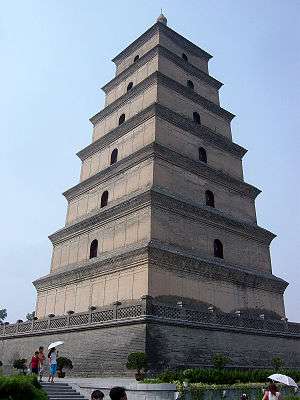
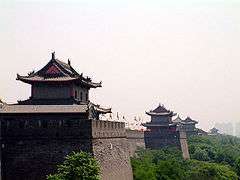

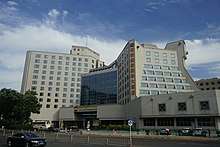
The number of travelers is often greater during Summer (May–August), although the most pleasant season for visiting Xi'an is Autumn.
Sites
Because of the city's many historical monuments and a plethora of ancient ruins and tombs in the vicinity,[10] tourism has been an important component of the local economy, and the Xi'an region is one of the most popular tourist destinations in China.[10]
The city has many important historical sites, and some are ongoing archaeological projects, such as the Mausoleum of Qin Shi Huang and his Terracotta Army. There are several burial mounds, tombs of the Zhou dynasty kings located in the city.[9] Xi'an also contains some 800 royal mausoleums and tombs from the Han dynasty,[105] with some of them yielding hundreds of sculpted clay soldiers, and remains of sacrificial temples from the Han era.[105] The city has numerous Tang dynasty pagodas and is noted for its history museum and its stele forest, which is housed in an 11th-century Confucian temple containing large stone tablets from various dynasties.[105]
Some of the most well-known sites in Xi'an are:
- The city is surrounded by a well-preserved city wall which was re-constructed in the 14th century during the early Ming dynasty and was based on the inner imperial palace of Tang dynasty.
- The Mausoleum of Qin Shi Huang and his Terracotta Army are located 40 km (25 mi) to the east of the city centre, in the city's suburbs.
- The Bell Tower and Drum Tower, both are located at the city's central axis.
- The city's Muslim Quarter, which is home to the Great Mosque of Xi'an.
- The Giant Wild Goose Pagoda and Small Wild Goose Pagoda are both spectacular towers and both are well over 1,000 years old and have survived great earthquakes. The former is next to a large square with the largest fountain in Asia which projects water high into the air, rising and falling in time to music during one of the daily performances (usually at noon and soon after sunset). They protected Buddhist writings in the past.
- The Stele Forest is famous for its numerous historic inscriptions and stoneworks[106]
- The Famen Temple and its towering pagoda located 120 kilometres (75 miles) west of Xi'an
- Xi Ming Temple
- Wolong Temple at Kaitong lane
- Xingjiao Temple at Shaolin Yuan (where Xuanzang's Tomb lies)
- Jianfu Temple
- Blue Dragon Temple
- Wangji Temple
- The Banpo Neolithic village is located on the outskirt of the city proper
- The Shaanxi History Museum has a large collection of artifacts both modern and ancient.
- Mount Zhongnan (终南山)
- Mount Li
- Huaqing Hot Springs, at the foot of Mt. Li, have a history of 6,000 years, the adjacent Huaqing Palace has a history of 3,000 years. Ranked among the Hundred Famous Gardens in China, it also has the status as a National Cultural Relic Protection Unit and a National Key Scenic Area.
- Daming Palace National Heritage Park, site of the former royal residence of the Tang dynasty emperors
Museums
- Terracotta Army Museum
- Shaanxi History Museum
- Stele Forest
- Xi'an Museum (located next to the Small Wild Goose Pagoda). On October 20, 2006, international council of monuments sites (ICOMOS) international protection centre (IICC) was formally established here.
- Tang Bo Art Museum
National parks
- Mount Cuihua National Geological Park (翠华山国家地质公园)
- Chanba National Wetland Park (浐灞国家湿地公园)
- Daming Palace National Heritage Park
- Mount Li National Forest Park
- Mount Wangshun National Forest Park (王顺山国家森林公园)
- Mount Zhongnan National Forest Park
- Hei He National Forest Park (黑河国家森林公园)
- Louguantai National Forest Park (楼观台国家森林公园)
- Taiping National Forest Park (太平国家森林公园)
- Zhuque National Forest Park (朱雀国家森林公园)
Sports
Cuju is a very old football game:
It was improved during the Tang dynasty (618–907). First of all, the feather-stuffed ball was replaced by an air-filled ball with a two-layered hull. Also, two different types of goalposts emerged: One was made by setting up posts with a net between them and the other consisted of just one goal post in the middle of the field. Chang'an was filled with cuju football fields, in the backyards of large mansions, and some were even established in the grounds of the palaces. The level of female cuju teams also improved. Records indicate that once a 17-year-old girl beat a team of army soldiers. Cuju football became popular among the scholars and intellectuals, and if a courtier lacked skill in the game, he could pardon himself by acting as a scorekeeper.
Professional sports teams in Xi'an include:
- Chinese Pingpong Association Super League
- Shaanxi Galaxy (陕西银河)
Former Professional sports teams in Xi'an:
- Chinese Jia-A League
- Shaanxi Guoli F.C. (陕西国力)
- Team dissolved in 2005
- Shaanxi Guoli F.C. (陕西国力)
- Chinese Football Association Super League
- Shaanxi Renhe Commercial Chanba F.C. (陕西人和商业浐灞)
- Team moved to Guizhou for the 2012 Chinese Super League season.
- Shaanxi Renhe Commercial Chanba F.C. (陕西人和商业浐灞)
- Chinese Basketball Association
- Shaanxi Dongsheng (陕西东盛)
- Team moved to Foshan and renamed themselves Foshan Dralions in 2010.
- Shaanxi Dongsheng (陕西东盛)
Xi'an is also the Chinese Boxing training base for the national team. The 60,000-capacity Xi’an Olympic Sports Centre Stadium, which opened in 2020, is the largest sports venue by capacity in Xi’an. It is used mostly for association football matches.
Media
Television and radio
- China Central Television's channel 1 through 12 is broadcast nationwide.
- Shaanxi Television (SXTV) provincial station, broadcasts on eight channels as well as a satellite channel for other provinces.
- Xi'an Television (XATV) municipal station, has six channels for specialized programming.
- Shaanxi Radio broadcasts music, news.
- Xi'an Music Radio: FM 93.1, broadcasts music, news and talkshows.
- Shaanxi Music Radio: Fm 98.8, broadcasts music, news and talkshows.
Printed media
- Chinese Business View (华商报) is a popular daily newspaper.
- Xi'an Evening News (Xi'an Wanbao) (西安晚报), with a history of more than 50 years, is one of the oldest newspapers.
- Sanqin Daily (三秦都市报) covers the news of Shaanxi Province.
- Shaanxi Daily (陕西日报) covers the news of Shaanxi Province and Xi'an.
Online media
- Xianease is a popular online and print magazine in Xi'an.
International relations
Xi'an's twin towns and sister cities are:
|
|
See also

- Chang'an
- Historical capitals of China
References
Citations
- Cox, W (2018). Demographia World Urban Areas. 14th Annual Edition (PDF). St. Louis: Demographia. p. 22. Archived (PDF) from the original on May 3, 2018. Retrieved November 16, 2017.
- 西安市2015年国民经济和社会发展统计公报. www.xatj.gov.cn/. Archived from the original on June 4, 2016. Retrieved May 12, 2016.
- OECD Urban Policy Reviews: China 2015, OECD READ edition. OECD iLibrary. OECD Urban Policy Reviews. OECD. April 18, 2015. p. 37. doi:10.1787/9789264230040-en. ISBN 9789264230033. ISSN 2306-9341. Archived from the original on March 27, 2017. Retrieved December 8, 2017.Linked from the OECD here Archived December 9, 2017, at the Wayback Machine
- "Xi'an". The American Heritage Dictionary of the English Language (5th ed.). Boston: Houghton Mifflin Harcourt. Retrieved April 14, 2019.
- "Xi'an". Collins English Dictionary. HarperCollins. Archived from the original on April 14, 2019. Retrieved April 14, 2019.
- "Xian" Archived April 14, 2019, at the Wayback Machine (US) and "Xian". Oxford Dictionaries UK Dictionary. Oxford University Press. Retrieved April 14, 2019.
- "Xi'an". Merriam-Webster Dictionary. Retrieved April 14, 2019.
- "Illuminating China's Provinces, Municipalities and Autonomous Regions". PRC Central Government Official Website. Archived from the original on December 24, 2014. Retrieved May 17, 2014.
- "Xi'an". Encarta. 1993–2008. September 3, 2008. Archived from the original on February 28, 2008. Retrieved February 6, 2016.
- "Xi'an". Encyclopædia Britannica. Archived from the original on December 4, 2008. Retrieved September 3, 2008.
- 中央机构编制委员会印发《关于副省级市若干问题的意见》的通知. 中编发[1995]5号. 豆丁网. Archived from the original on May 29, 2014. Retrieved May 28, 2014. |date=1995-02-19 |accessdate=2014-05-28 |url-status=dead|archiveurl= |archivedate=2014-05-29 }}
- 最新中国城市人口数量排名(根据2010年第六次人口普查). www.elivecity.cn. 2012. Archived from the original on March 3, 2015. Retrieved May 27, 2014.
- "Supersized cities: China's 13 megalopolises". Archived from the original on July 21, 2012. Retrieved July 20, 2012.
- Du Halde (1736), pp. 220–1; Du Halde (1741), pp. 227–8.
- Stanford (1917), p. 13 & Index, p. 11.
- 《中国古今地名大词典》 [The Big Dictionary of Old and Current Chinese Placenames], Shanghai: Shanghai Cishu Chubanshe, 2005, p. 1540.
- Yang, Xiaoping (2010). "Climate Change and Desertification with Special Reference to the Cases in China". Changing Climates, Earth Systems and Society. pp. 177–187. doi:10.1007/978-90-481-8716-4_8. ISBN 978-90-481-8715-7.
- Stark, Miriam T (April 15, 2008). "East Asian plant domestication". Archaeology of Asia. pp. 77–95. ISBN 9781405153034.
- Fuller, Dorian Q; Qin, Ling; Harvey, Emma (2008). "A Critical Assessment of Early Agriculture in East Asia, with emphasis on Lower Yangzte Rice Domestication" (PDF). Pragdhara: 17–52. Archived (PDF) from the original on September 24, 2015. Retrieved May 28, 2014.
- Meng, Y; Zhang, HQ; Pan, F; He, ZD; Shao, JL; Ding, Y (2011). "Prevalence of dental caries and tooth wear in a Neolithic population (6700-5600 years BP) from northern China". Archives of Oral Biology. 56 (11): 1424–35. doi:10.1016/j.archoralbio.2011.04.003. PMID 21592462.
- "Banpo Museum in Xi'an". chinamuseums.com. Archived from the original on January 31, 2018. Retrieved July 29, 2013.
- Third scroll of the Chang'an Annals (长安志) interpreted by Huangfu Mi in his Age of the Kings (book) (帝王世紀)
- "China's six major historical capitals – Xi'an's cultural history". Archived from the original on July 24, 2011. Retrieved February 22, 2011.
- 中国古今地名大词典 (in Chinese). Shanghai: Shanghai Lexicographical Publishing House. 2005. p. 2134.
- O. Louis Mazzatenta (October 9, 2009). "Emperor Qin's Terracotta Army". National Geographic. Archived from the original on May 28, 2014. Retrieved May 28, 2014.
- "Weiyang Palace: the Largest Palace Ever Built on Earth". Archived from the original on March 3, 2016. Retrieved November 4, 2014.
- 西安历史 (in Chinese). Archived from the original on February 11, 2011. Retrieved February 22, 2011.
- Kiang, 12.
- Hill, Henry, ed (1988). Light from the East: A Symposium on the Oriental Orthodox and Assyrian Churches. Toronto, Canada. pp. 108–109
- Jenkins, Peter (2008). The Lost History of Christianity: the Thousand-Year Golden Age of the Church in the Middle East, Africa, and Asia – and How It Died. New York: Harper Collins. pp. 65. ISBN 978-0-06-147280-0.
- Ernest Frank Borst-Smith, Caught in the Chinese Revolution: a record of risks and rescue. London: T. Fisher Unwin, 1912.
- Crossley, Pamela Kyle (1991). Orphan Warriors: Three Manchu Generations and the End of the Qing World (illustrated, reprint ed.). Princeton University Press. p. 197. ISBN 0691008779.
- Backhouse, Sir Edmund; Otway, John; Bland, Percy (1914). Annals & Memoirs of the Court of Peking: (from the 16th to the 20th Century) (reprint ed.). Houghton Mifflin. p. 209.
- The Atlantic, Volume 112. Atlantic Monthly Company. 1913. p. 779.
- The Atlantic Monthly, Volume 112. Atlantic Monthly Company. 1913. p. 779.
- Rhoads, Edward J. M. (2000). Manchus and Han: Ethnic Relations and Political Power in Late Qing and Early Republican China, 1861–1928 (illustrated, reprint ed.). University of Washington Press. p. 192. ISBN 0295980400.
- Rhoads, Edward J. M. (2000). Manchus and Han: Ethnic Relations and Political Power in Late Qing and Early Republican China, 1861–1928 (illustrated, reprint ed.). University of Washington Press. p. 193. ISBN 0295980400.
- Fitzgerald, Charles Patrick; Kotker, Norman (1969). Kotker, Norman (ed.). The Horizon history of China (illustrated ed.). American Heritage Pub. Co. p. 365.
- Edward J. M. Rhoads (2000). Manchus and Han: Ethnic Relations and Political Power in Late Qing and Early Republican China, 1861–1928. University of Washington. p. 191. ISBN 9780295980409.
- Guo Rugui, 《中国抗日战争正面战场作战记》 ,第二部分:从“九一八”事变到西安事变 绥远抗战的巨大影响和军事上的经验
- 西安市历史沿革 (in Chinese). City of Xi'an. Archived from the original on July 7, 2011. Retrieved February 22, 2011.
- 打砸抢烧不是爱国是害民. Beijing Youth Daily (in Chinese). September 16, 2012. Archived from the original on April 22, 2017. Retrieved September 16, 2012.
- "Xi'an Protesters Overturn Cars". Retrieved September 17, 2012.
- "Anti-Japan Protests In China Swell, Turn Violent". Huffington Post. September 15, 2012. Archived from the original on March 4, 2016. Retrieved September 17, 2012.
- 《史记·留侯世家》
- "Archived copy". Archived from the original on March 18, 2013. Retrieved February 18, 2013.CS1 maint: archived copy as title (link)
- "Extreme Temperatures Around the World". Archived from the original on August 4, 2014. Retrieved February 21, 2013.
- 中国气象局 国家气象信息中心 (in Chinese). China Meteorological Administration. June 2011. Archived from the original on July 16, 2009. Retrieved March 17, 2009.
- NTSC Archived March 4, 2016, at the Wayback Machine 国家授时中心简介
- 西安人口 [Xi'an population] (in Chinese). City of Xi'an. Archived from the original on March 22, 2007. Retrieved May 16, 2007.
- 4-5各市、县(市、区)常住人口(2013-2014年)-tjsql.com. www.tjsql.com. June 2018. Archived from the original on December 20, 2016. Retrieved March 6, 2016.
- "World urban areas" (PDF). Archived (PDF) from the original on May 3, 2018. Retrieved November 16, 2017.
- "Archived copy" 西安市2010年第六次全国人口普查主要数据公报 (in Chinese). Xi'an Evening News (西安晚报). May 25, 2011. Archived from the original on February 20, 2014. Retrieved July 3, 2014.CS1 maint: archived copy as title (link)
- People's Republic of China County-level Division Population Statistics (《中华人民共和国全国分县市人口统计资料2010》).
- "Archived copy" 国家统计局统计用区划代码. National Bureau of Statistics of the People's Republic of China. 2012. Archived from the original on April 7, 2012. Retrieved January 27, 2013.CS1 maint: archived copy as title (link)
- Cáo Yùzhēn 曹玉珍, ed. (2011). Guìyáng tǒngjì niánjiàn 2011 贵阳统计年鉴2011 [Guiyang Statistical Yearbook 2011] (in Chinese). Zhōngguó tǒngjì chūbǎn shè. ISBN 978-7-5037-6310-6.
- Chén Yuèliáng 陈越良, ed. (2011). Zhōngguó Mínzhèng Tǒngjì Niánjiàn 2011 中国民政统计年鉴2011 [China Civil Affairs' Statistical Yearbook 2011]. Beijing: Zhōngguó tǒngjì chūbǎn shè. ISBN 978-7-5037-6306-9.
- -中国公交信息网. www.bus-info.cn. Archived from the original on August 1, 2017. Retrieved July 3, 2017.
- 小雪, 翟 (July 4, 2014). 西安机动车数量突破200万辆. 西安晚报. Archived from the original on September 12, 2014.
- 西安地铁二号线开通 西安迈入"地铁时代" [Xi'an Metro line brings Xi'an into the "metro era"]. China National Radio (in Chinese). Beijing. September 16, 2006. Archived from the original on October 8, 2012. Retrieved May 28, 2014.
- "Xi'an Subway Line 2 to begin trial runs on September 28". Global Times. June 29, 2011. Archived from the original on October 16, 2012.
- 市政府召开西安地铁开通试运营新闻发布会 (in Chinese). September 16, 2011. Archived from the original on November 14, 2011. Retrieved October 3, 2012.
- "Xian: the Building of Subway to Start This Year". Travel China Guide. September 14, 2006. Archived from the original on January 3, 2014.
- "Xi'an Transportation" ChinaTour.Net Archived April 2, 2015, at the Wayback Machine Accessed December 4, 2014
- "Archived copy" 一、二、三、四号线首末班车时刻表. Xi'an Metro. Archived from the original on January 3, 2019. Retrieved February 25, 2019.CS1 maint: archived copy as title (link)
- "Subway Collapse Kills Two in Xi'an". CRIENGLISH.com. China Radio International. August 3, 2009. Archived from the original on May 29, 2014. Retrieved May 28, 2014.
- "Growth to continue". Railway Gazette International. DVV Media UK. March 3, 2011. Archived from the original on March 9, 2011. Retrieved May 28, 2014.
- Tang Ru (September 20, 2008). 郑西客运专线西安北站将建成大型综合交通枢纽中心 [Zhengzhou to Xi'an: Xi'an North Passenger Station will be a large-scale transport hub]. China Railway Network (in Chinese). www.railcn.net Corporation. Archived from the original on March 4, 2016. Retrieved February 6, 2016.
- 西安北列车时刻表 [Xi'an North train schedule]. ip138.com. Archived from the original on March 4, 2016. Retrieved December 5, 2018.
- Zhengzhou-Xi'an high-speed train starts operation. China Daily. February 6, 2010 [archived February 3, 2015; Retrieved 2010-02-06].
- High-speed rail linking central, western China starts operation. iStockAnalyst. February 6, 2010 [archived February 8, 2010; Retrieved 2010-02-06].
- High-speed train debuts in W. China. CCTV. February 6, 2010 [archived January 6, 2014; Retrieved 2010-02-06].
- China express train forces airlines to stop flights. 2010-03-26 [archived March 30, 2010; Retrieved 2010-03-28]. Reuters.
- 陕西年鉴1992 [Shaanxi Yearbook 1992]. Archived from the original on May 29, 2014.
- "Xian Airport opens new terminal building with strong focus on retail growth". Archived from the original on May 23, 2014. Retrieved May 28, 2014.
- News report from the New York Times.
- News report from the Kingston Gleaner. Archived May 26, 2011, at the Wayback Machine NewspaperArchive.com
- Accident description at the Aviation Safety Network
- "Trouble in Textile Town – Global Times". Archived from the original on September 14, 2017. Retrieved January 31, 2016.
- Xu Wei to rock fans in grand concert. Shenzhen Daily. 2005-07-05 [archived September 24, 2015; Retrieved 2014-05-28]. China Daily.
- 陕西小吃-羊肉泡馍. News.xinhuanet.com. Archived from the original on November 26, 2013. Retrieved May 28, 2014.
- "China promove programas diversificados durante o Festival da Primavera". China Radio International. February 8, 2008. Archived from the original on March 4, 2016. Retrieved November 17, 2010. (English Archived November 17, 2015, at the Wayback Machine)
- "Chinese opera The First Emperor transmitted live into theaters worldwide". People's Daily. January 14, 2007. Archived from the original on May 29, 2014. Retrieved November 17, 2010.
- Yuet Chau, Adam (2006). Miraculous response: doing popular religion in contemporary China. Stanford University Press. p. 53. ISBN 9780804767651. Archived from the original on January 2, 2016. Retrieved November 17, 2010.
- Martin Palmer, The Jesus Sutras: Rediscovering the Lost Religion of Taoist Christianity, ISBN 0-7499-2250-8, 2001
- Fleming, Peter (1936) News from Tartary. London: Jonathan Cape; pp. 46–48
- Shorrock, Arthur Gostick (1926). Shensi in Sunshine and Shade. Shanghai: Presbyterian Mission Press.
- "Duncan Papers (Mundus Gateway to missionary collections in the United Kingdom)". Angus Library, Regents Park College. Archived from the original on October 11, 2013. Retrieved August 14, 2013.
- Burt, Ernest Whitby (1925). Fifty Years in China: The Story of the Baptist Mission in Shantung, Shansi, and Shensi, 1875–1925. London: The Carey Press.
- Glover, Richard (1914). Herbert Stanley Jenkins, medical missionary, Shensi, China: with some notices of the work of the Baptist Missionary Society in that country (1914). London: Carey Press. p. 155. ISBN 978-0-524-07100-7. Archived from the original on March 7, 2016. Retrieved November 15, 2015.
- Duncan, Moir Black (1900). The missionary mail to faithful friends and candid critics (the substance of letters written from Shên His). London: Elliot Stock.
- Zhang, Zhizhong. 中国七大中心城市人口资源大调查 [Population survey of the seven central cities of China]. National Family Planning Commission. Archived from the original on September 23, 2015. Retrieved August 21, 2013.
- Mosques in Xian Archived April 30, 2017, at the Wayback Machine from www.muslim2china.com
- Walcott, Susan (April 17, 2010). "Xi'an's Maturing Economy". Retrieved June 1, 2013.
- "Xi'an ( Shaanxi ) City Information". August 29, 2011. Archived from the original on May 5, 2015. Retrieved June 1, 2013.
- "City Report: Xi'an". January 17, 2007. Archived from the original on October 3, 2014. Retrieved June 2, 2013.
- "Xi'an Economy". The People's Government of Shaanxi. January 1, 2008. Archived from the original on March 3, 2016. Retrieved June 2, 2013.
- "Xi'an". Lehman, Lee & Xu. Archived from the original on June 29, 2013. Retrieved June 2, 2013.
- "Archived copy". Archived from the original on May 28, 2015. Retrieved April 23, 2014.CS1 maint: archived copy as title (link)
- "China's mega-dump already full - 25 years early". BBC News. November 15, 2019. Archived from the original on December 3, 2019. Retrieved November 15, 2019.
- "Xi'an software park". www.xdz.com. Archived from the original on February 11, 2018. Retrieved February 10, 2018.
- "People's Daily". Archived from the original on September 4, 2008. Retrieved October 1, 2007.
- Bureau of Commerce of Xi'an Municipal Government Archived October 16, 2012, at the Wayback Machine
- "Xi'an to Host World Horticultural Expo" Archived October 17, 2007, at the Wayback Machine China.org.cn
- "Xi'an". The Columbia Encyclopedia, Sixth Edition. Archived from the original on June 6, 2011. Retrieved September 3, 2008.
- "Archived copy". www.bbc.com. Archived from the original on April 12, 2019. Retrieved April 12, 2019.CS1 maint: archived copy as title (link)
- "Sister Cities of Kyoto City". City of Kyoto. Archived from the original on January 21, 2014. Retrieved January 21, 2014.
- "Edinburgh – Twin and Partner Cities". 2008 The City of Edinburgh Council, City Chambers, High Street, Edinburgh, EH1 1YJ Scotland. Archived from the original on March 28, 2008. Retrieved December 21, 2008.
- "Twin and Partner Cities". City of Edinburgh Council. Archived from the original on June 14, 2012. Retrieved January 16, 2009.
- "List of Twin Towns in the Ruhr District" (PDF). Twins2010.com. Archived from the original (PDF) on November 28, 2009. Retrieved October 28, 2009.
- "SISTER CITY PARTNERSHIP OFFICIALLY FORMALIZED BETWEEN PENANG, MALAYSIA AND XI'AN, SHAANXI PROVINCE, CHINA". SEIA. October 27, 2014. Archived from the original on March 6, 2017. Retrieved March 6, 2017.
- "Proposed Twinning of Kota Kinabalu and Xi'an as Sister Cities". Sabah News Today. June 4, 2019. Archived from the original on September 26, 2019. Retrieved September 26, 2019.
- "DBKK, X'ian association to sign MoU". The Borneo Post. July 23, 2019. Archived from the original on September 26, 2019. Retrieved September 26, 2019.
Bibliography
- Du Halde, Jean-Baptiste (1736), Description Géographique, Historique, Chronologique, Politique, et Physique de l'Empire de la Chine et de la Tartarie Chinoise [A Geographical, Historical, Chronological, Political, and Physical Description of the Empire of China and Chinese Tartary, The Hague: H. Scheurleer. (in French)
- Du Halde, Jean-Baptiste (1741), Brookes, Richard (ed.), The General History of China, 3rd ed., London: J. Watts.
- Heng Chye Kiang (1999), Cities of Aristocrats and Bureaucrats: The Development of Medieval Chinese Cityscapes, Singapore: Singapore University Press, ISBN 978-9971-69-223-0.
- Stanford, Edward (1917), Complete Atlas of China, 2nd ed., London: China Inland Mission.
- Woo, J.K. (1964), "A Newly Discovered Mandible of the Sinanthropus Type: Sinanthropus Lantianensis", Scientia Sinica, Vol. 13: 801–811, PMID 14170540.
External links
| Wikimedia Commons has media related to Xi'an. |
| Wikivoyage has a travel guide for Xi'an. |
- Xi'an City Government official website
- Xi'an National Hi-tech Development Zone
- Xi'an in Chinese history
| Preceded by Yin |
Capital of China (as Hao) 1046–771 BC |
Succeeded by Luoyang |
| Preceded by Xianyang |
Capital of China (as Chang'an) 206 BC – 25 |
Succeeded by Luoyang |
| Preceded by Luoyang |
Capital of China (as Chang'an) 190–196 |
Succeeded by Xuchang |
| Preceded by Jiankang |
Capital of China (as Daxing) 581–618 |
Succeeded by itself, as Chang'an |
| Preceded by itself, as Daxing |
Capital of China (as Chang'an) 618–907 |
Succeeded by Kaifeng |

